


The Potential Individual Financial Impact of “Project 2025”
There has been substantial conversation about “Project 2025” policies put forward by more than 100 republican think tanks and spearheaded by The Heritage Foundation. It is important to understand the potential individual financial impact that Project 2025 may have on your life as you consider this controversial election.
Project 2025 has become the blueprint for the Republicans’ platform for this year’s presidential election. While the Republican nominee has made attempts to distance himself from Project 2025, the forward for the book itself was written by none other than Vice Presidential candidate JD Vance. Many central figures responsible for Project 2025 presently or formerly worked for the Republican presidential nominee.
Project 2025 proposes immediate substantial reductions in the federal student loan forgiveness programs managed by the U.S. Department of Education. Millions of those with student loans would be affected. The proposal would eliminate public service loan forgiveness altogether for those who work in government or nonprofit positions and would otherwise qualify for loan cancellation after ten years of payments. “SAVE,” a Biden administration student loan repayment initiative, would immediately end, as would protections put in place for students who have been defrauded (such as in the case of the $25 million Trump University settlement) through Borrower’s Defense regulations.
How would Project 2025 affect your individual taxation? The 2017 Tax Cuts and Jobs Act, TCJA, lowered income taxes by raising the ceiling of each bracket before the taxpayer paid an increased percentage while increasing the standard deduction. As a result, millions more American taxpayers are free from needing to itemize deductions to reduce their taxable income. The TCJA also impacted estate and gift tax exemptions, the Qualified Business Income deduction for owners of pass-through entities, and increased the child tax credit. These provisions are all scheduled to sunset at the end of 2025.
Project 2025 calls for a new “simple two-rate individual tax system.” Americans would pay a flat rate of 15% or 30% based upon income above or below the Social Security wage basis (presently $168,600). Based on the latest year for which these figures are available (2021), half of Americans pay less than 5% in net income taxes after deductions.
Is this a good financial idea for you personally? There is a simple way to find out. If you pull out your 2023 tax return and take the number from line 24 (“This is your total tax”) and divide it by the amount on line 9 (“This is your total income”), you will arrive at the net income tax percentage you paid in 2023. For example, if the U.S. taxpayer owed a total tax of $9,591 on line 24 of their 1040 and showed a total income of $100,0000 on line 9 of their 1040, they would divide 9,591 by 100,000 and come up with .0959, or 9.6% as an actual net tax rate. This is far less than the $15,000 a flat tax of 15% would have required for the income of $100,000. In other words, the U.S. taxpayer in this example would be required to pay 50% more in income tax based upon a flat tax rate of 15% than on the rates of tax year 2023.
In addition, Project 2025 calls for the implementation of a “consumption tax” (read: National Sales Tax) on the purchase of goods and services.
While modifications to Social Security are not mentioned by name (as this would be political suicide), Project 2025 does establish a balanced federal budget as a “mission-critical objective.” Concerns regarding the solvency and stability of existing Social Security trust funding are well documented. The most recent annual report for the fund projects a 20% cut in Social Security benefits beginning in 2035 if Congress does not act to increase Social Security funding. It doesn’t take a lot of reading between the lines to determine the fate of Social Security under Project 2025.
Project 2025 calls for a major “reform” of SNAP, the Supplemental Nutrition Assistance Program. SNAP provides assistance to low-income Americans to help them provide food for their families. Project 2025 also calls for an end to the “entitlement program” of federal school meals. The impact of these cuts on the health and viability of lower-income Americans is hard to understate.
What is the central theme of Project 2025? Their own website plainly states: “If we are going to rescue the country from the grip of the radical Left, we need both a governing agenda and the right people in place, ready to carry this agenda out on day one of the next conservative administration. This is the goal of the 2025 Presidential Transition Project.”
The document is almost 1000 pages long and is intended to provide a roadmap for a Republican administration and to restructure the American government. The plan establishes a new process to ensure “the right people are in place at every level of the U.S. government to carry out this vision.” Some have warned Project 2025 is “a remarkably detailed guide to turning the United States into a fascist’s paradise” and purging the existing federal workforce of thousands and thousands of existing government workers in order to replace them with those who are prepared to “adhere to the principles of Project 2025.”
Project 2025 would provide substantial tax cuts for the wealthiest of Americans while increasing the income tax burden of more than half of American taxpayers. Substantial cuts to student loan forgiveness programs, the elimination of TCJA tax advantages for the majority of Americans, significant reductions to the safety net that protects the poorest of us, and a less than veiled threat to Social Security are the promises of Project 2025. Not to mention a total overhaul of the government workforce to make sure, unlike in December 2020 and January 2021, “the right people” are in place to carry out the plan this time.
The potential individual financial impact of “Project 2025” will simply not benefit most Americans, including more than half of U.S. taxpayers, senior citizens, the poorest among us, and even those who merely carry the debt of a college education.
